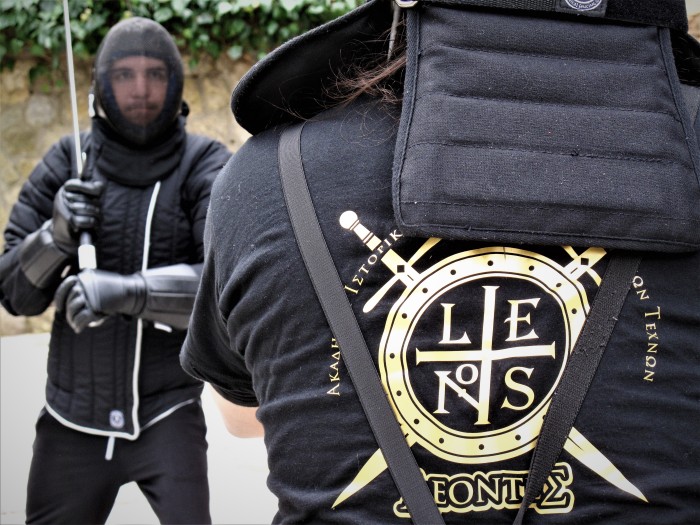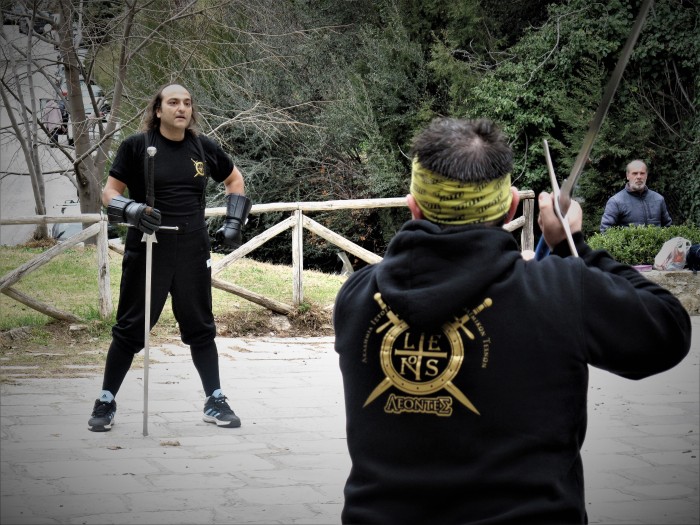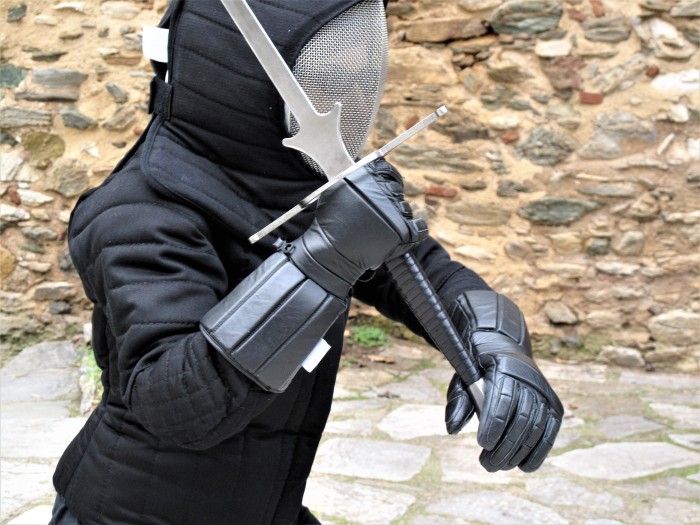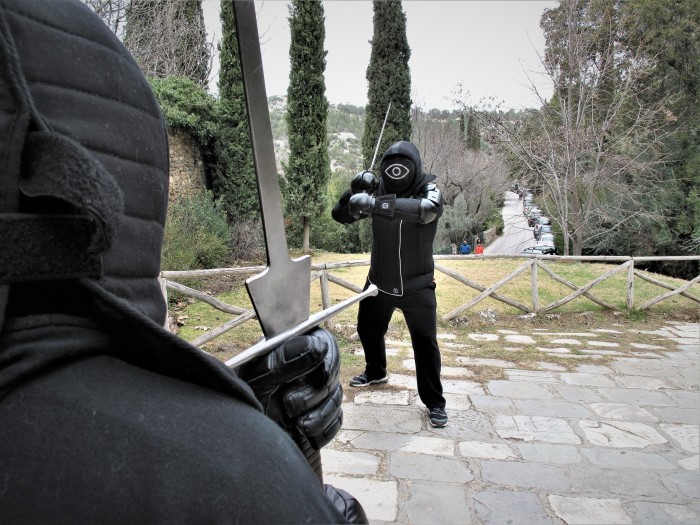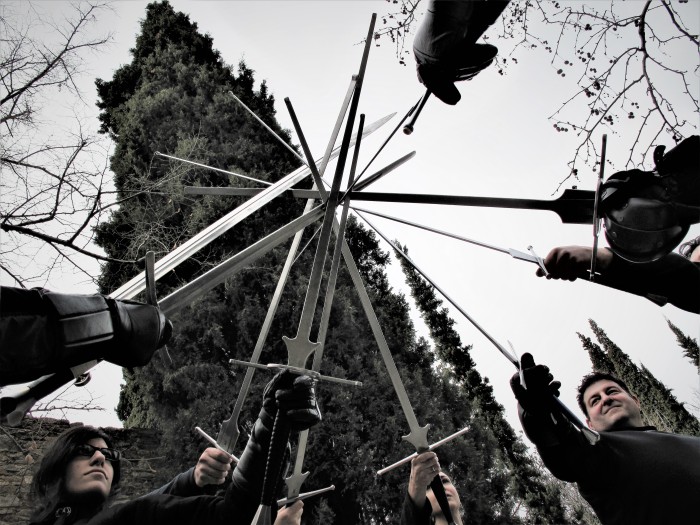
 Τη Κυριακή 5 Φεβρουαρίου 2017, διεξήχθη επιτυχώς Εργαστήριο Ιστορικής Ξιφασκίας με θέμα η ξιφομαχία με Μακρύ Σπαθί από το Codex Danzig (1452) του Peter von Danzig zum Ingolstadt, Μέρος 2o.
Τη Κυριακή 5 Φεβρουαρίου 2017, διεξήχθη επιτυχώς Εργαστήριο Ιστορικής Ξιφασκίας με θέμα η ξιφομαχία με Μακρύ Σπαθί από το Codex Danzig (1452) του Peter von Danzig zum Ingolstadt, Μέρος 2o.
Οι ασκούμενοι εκπαιδεύτηκαν πάνω την ερμηνεία της κατάστασης ‘Πριν’ , ‘Μετά’, ‘Ανάμεσα’. Το ‘ασθενές’ και το ‘ισχυρό’. Πως επιτίθεσαι στα 4 ανοίγματα. Πως σταματας τις επιθέσεις των τεσσάρων ανοιγμάτων με το Διπλασιασμό (Duplieren) και τη Μεταλλαγή (Mutiren), σύμφωνα με το εγχειρίδιο οπλομαχίας με τίτλο Η ξιφομαχία με Μακρύ Σπαθί από το Codex Danzig (1452) του Peter von Danzig zum Ingolstadt.
Ακολουθήσαμε το κείμενο από τη μετάφραση του Cory Winslow και στη Γερμανική (Rome Transcription (1452) μετάφραση του Dierk Hagedorn
Cod. 44.A.8 (1452)
[11] This is the text and the gloss of yet another lesson:
| 17 |
Before and After, these two things, |
| 18 |
Weak and Strong, |
| 19 |
So you may learn |
| 20 |
If you readily frighten, |
Gloss: Mark, this is that before all things you shall rightly undertake and understand these two things, which are the Before and the After, and thereafter the Weak and Strong of the sword, and then the word “Meanwhile”, whence comes the entire foundation of all the Art of Fencing. When you think on, undertake, and understand them rightly, and do not forget the word “Meanwhile” in all techniques that you drive, then you are a very good Master of the Sword and may teach princes and lords well, so that they may be best in combat and in earnest with the correct Art of the Sword.
Das ist der text vnd die glos aber von einer ler
Vor vnd nach dÿ tzwaÿ dinck
Sind aller ku~st ein vrspring
Swech vnd sterck
Inndes das wort do mit merck
So magstu lerñ
Mit kunst arbaitten vnd weren
Der schrickestu gerñ
kain uechtñ nÿmer gelerñ
|Glosa |Merck das ist das du vor allen sachen recht solt vernemen |vnd ver sten dy tzwaÿ dinck |Das ist das vor |vnd das nach |vnd dar nach swech vnd sterck des swertzs |vnd des wortz inndes |wenn dar aus get der gantz grunt aller kunst des fechtens |wenn du die dinck recht vernÿmpst |vñ verstest |vnd dar zu° des wortz Inndes nicht vergist |In allen stucken die dw treibest |So pistu wol ein gueter maister des swertz |vnd magst wol lernen fürsten |vnd herren das sÿ mit rechter gunst des swertz wol mügen besten |In kampff |vnd in erñst
|
[12] Here mark what is there called the Before: This is that you shall always come Before (be it with the hew or with the stab) before he does. And when you come before with the hew or otherwise, then he must parry that, so work Meanwhile nimbly before yourself with the sword in the parrying, or otherwise with other techniques. Then he may come to no work. |
|
Hye merck was da haist das nach
|Das nach das sind die prüch wider alle stuck |vnd häw die man auff dich treibt |vnd das vernÿm also |wenn er ee ku~pt mit dem haw |wenn du das im versetzen muest |So arbait Inndes mit dein° vorsatzung behendlich mit dem swert zu° der nagsten plöss |So prichstu ÿm sein vor mit deinem nach
|
[13] Here mark what is there called the After: The After are the breaks against all techniques and hews the opponent drives on you, and that undertake thus: When he comes Before with the hew, and you must parry him, then work Meanwhile with your parrying nimbly with the sword to the next opening. Then you break his Before with your After. |
Hier merck die swech vnd die sterck des swertz
|Die swech |vnd die sterck |vernÿm also am swert von dem gehültz pis in die mitt der klingen so ist die sterck des swertz |vnd fürpas vber die mitt pis an den ort ist die swech |vnd wie du mit der sterck deines swertz nach der swech seins swertz arbaitten solt das wir dir hernach vorklert
|
[27] This is the text and the gloss of the Four Openings:
Gloss: Mark, whoever will be a Master of the Sword, he shall know how one shall search the Four Openings with art, if he will otherwise fence correctly and wisely. The first opening is the right side, the other the left, of the upper-half above the girdle of the man. The other two openings are the right and left side of the lower-half below the girdle. Now, there are two drivings whence one shall search the openings. First, one shall search from the pre-fencing with Travelling-after and with shooting-in the long point. Secondly, one shall search with the Eight Windings when one has bound the other on the sword. |
Das ist der text vnd die glos von den vier plössen
Vier plossen wisse
Reme so slechstu gewisse
In alle far
An tzweifel wie er gepar
|Glosa |·M·erck wer ein maister des swertz sein wil |Der sol wissen wie man die vier plöss mit kunst suechen sol |wil er anders gerecht vnd gewis vechten |Die erst plöss ist die recht seit |die ander die linck oberhalb der [15v] gürtel |des mans |die anderñ zwo plöss das sind auch die recht vnd linck seÿtt vnderhalb der gurtel |Nu sind zwaÿ gefert dar aus man die plössen suechen sol |Zw dem ersten sol man sÿ suechen aus dem zw fechten mit nach raÿsen |vnd mit ein schiessen des langen ortes |Zw dem anderñ mal sol man sÿ suechen mit den acht winden |wenn einer dem anderñ an das swert gepunden hat
| [28] That you shall thus understand: when you come to him with the pre-fencing, you shall always aim at the Four Openings boldly without any fear (with a hew or with a stab, to whichever you may best come on) and regard not what he drives or fences against you. Therewith, you force the man so that he must parry you, and when he has parried, then search quickly in the parrying with the Winding on his sword yet to the next opening, and thus aim always at the openings of the man and fence not to the sword, as in the technique which says, “Set-on four ends; Learn to remain thereon if you will end.”[9] |
|Das soltu also ver sten |wenn du mit dem zw° vechten zu° ÿm kumst das dw albeg mit einem haw oder mit einem stich kunleich an alle vorcht solt reme~ der vier plössen eine |zu welicher dw am pesten kumen magst |vnd acht nicht was er gegen dir treibt oder vicht |Do mit twingstu den man das er dir vor setzen mues |vnd wenn er hat versetzt |so suech pald in der versatzu~g mit den winden an seinem swert aber die nagst plöss |vnd also rem albeg der plössen des mans |vnd vicht nicht zw dem swert |In dem stuck das da also spricht |Setz an vier enden pleib dar auff lere wiltu enden ~
[29] This is the text and the gloss how one shall break the Four Openings:
Gloss: Mark, when one earnestly hews in at you, if you will then reckon on him and win on the openings with art, so that he must let you strike without thinking, then drive the Doubling against the Strong of his sword, and the Mutating when he is Weak on the sword. So I say to you truthfully that he may not protect himself from strikes before you, and cannot come to strikes himself. |
Das ist der text vnd die glos wie man die vier plössen sol prechñ
Wiltu dich rechen
Die vier plöss kunstlich prechen
Oben duplier
Niden recht mutir
Ich sag dir für wär
Sich schutzt [16r] kain man ane far
Hastu vernomen
zu° slag mag er klain kümen etc
|Glosa |Merck wenn dir einer erñstlich ein hawt |wiltu dich dann an im rechten |vnd ÿm die plössen mit kunst an gewinnen das er sich an seinem danck slahen mues lassen |So dreib das duplirñ gegen der sterck seins swertz |vnd das mutirñ |wenn er swach am swert ist |So sag ich dir fur war |Das er sich für dir vor slegen nicht beschützen mag |vnd kan selber zu° slegen nicht kümen
[30] Here mark how you shall drive the Doubling to both sides:
Mark, when he hews above to you from his right shoulder: then hew also from your right with him, likewise above strongly to the head. If he parries and remains Strong on the sword, then drive up Meanwhile with your arms, and thrust your sword’s pommel with your left hand under your right arm, and strike in with the long edge with crossed arms, behind his sword’s blade on his head.
Hye merck wie du das duplierñ treiben solt zw paiden seitten
|Merck wenn er dir oben zu° haut von seiner rechten achsal |So haw auch von deiner rechten mit ym geleich oben starck ein zu° dem kopff |ver setzt er |vnd beleibt starck am swert |So var Indes auff mit den armen |vnd stos mit der lincken hant dein swertz knopff vnder deinen rechten arm~ |vnd slach ÿn mit der langen schneid aus gekreutzten arm~ hinder seiner swertz klingen auff den kopf ~
[31] Another:
Mark, if he hews you with the long edge in to your head from above his left shoulder, and you do likewise, if he then remains Strong on the sword again, then quickly drive up with your arms and strike in with the short edge, behind his sword’s blade on his head.
[32] Thus you have learned to bring your sword to the War and pass through it.
Ein anders
|Merck haut er dir von seiner lincken achsal mit der langen schneid oben ein zw dem kopff vnd tue ym also [16v] |wider bleibt er denn starck am swert |So var pald auff mit den armen |vnd slach yn hinder seiner swertz klingen mit der kurtzen schneid auff den kopff
